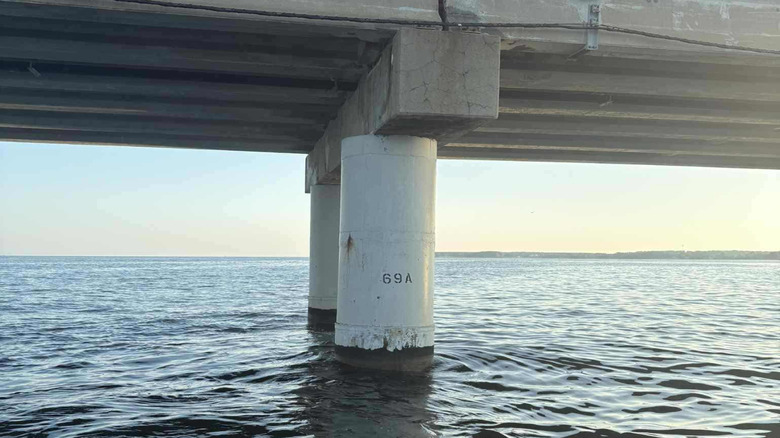The Chesapeake Bay Bridge Isn't Collapsing, But This Viral Photo Sure Looks Bad
The Maryland Transportation Authority has assured residents that one of its most-used bridges is perfectly safe, despite a viral photograph appearing to show its support beams had moved off-center. Connecting Annapolis and Kent Island, the Chesapeake Bay Bridge has been a staple of the DMV area since 1952. Not to be confused with the Chesapeake Bay Bridge Tunnel, one of the country's longest bridges, the 4.2-mile stretch of Route 50 is a critical roadway for commuters traveling between Maryland, Washington D.C., and Delaware; hosting more than 25 million vehicles annually.
Officially known as the William Preston Lane Jr Memorial Bridge, it was one of the world's largest bridges at the time of its construction. In recent years, however, the structure has garnered an infamous reputation as being one of the scariest drives in America, with some commuters reportedly paying drivers to shepherd them across it. Fear is so prevalent among commuters that it's become a business model, with companies like the Kent Island Express offering 24/7 drive-over services.
The viral sensation started when a concerned fisherman snapped a photo showing that the bridge's support beams had seemingly shifted. The controversy comes just a few months after the National Transportation Safety Board expressed concerns about the bridge's safety. According to the NTSB, the Chesapeake Bay Bridge was one of several DMV bridges susceptible to bridge strikes: Strikes remain a key concern for residents after a cargo ship struck Baltimore's Francis Scott Key Bridge the year prior, killing 6 people and costing an estimated $2 billion in damage. After an inspection, however, the Maryland Transportation Authority has assured residents that there are no issues with the bridge's support beams.
Safety concerns
The viral photo, pictured above, appears to show that the base of the bridge has moved off-kilter. In it, the bridge girders supporting the bridge appear to have shifted off the center of the pier cap. Fortunately, the picture prompted an inspection by the Maryland Transportation Authority. According to a statement from the organization, via CBS News, the bridge's girders remain properly positioned and have "not changed since the bridge's construction." The MDTA also stressed that the bridge had passed its annual safety inspection for 30 years running.
Despite these assurances, the picture struck a chord in a community still reeling from the fallout of recent bridge collapses. The disaster has prompted observers to re-examine the state of the nation's bridge infrastructure, hoping to determine the cause of bridge collapses and to prevent further incidents. One such investigation, launched by the National Transportation Safety Board, recommended that 68 bridges across 19 states receive further inspection. The findings come after authorities have spent an estimated $175 million maintaining and updating the bridge over the past decade.
During a press conference announcing the studies' results, NTSB chairwoman Jennifer Homendy chastised the Maryland Transportation Authority's handling of bridge safety, noting that the collision risk for the Francis Scott Key bridge was 30 times the risk threshold. The Maryland Transportation Authority, for its part, stated that the Chesapeake Bay Bridge was safe to use despite the NTSB's findings. Updates to the Chesapeake Bay Bridge currently under consideration revolve around minimizing this collision risk, and include measures like pier fenders and water-based structures known as dolphins.

